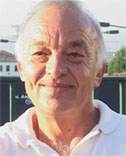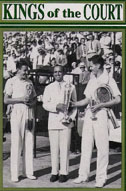Bobby Riggs:
The Complete Natural
By Ed Atkinson
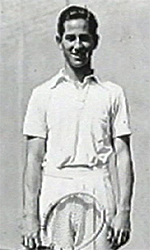 |
A natural who won his first racket playing marbles. |
After Don Budge achieved the first Grand Slam in 1936, he turned pro to tour against Ellsworth Vines. Waiting his turn to take the crown of amateur tennis into his eager young hands was another boy who grew up on the cement courts of the Los Angeles Tennis Club. His name was Bobby Riggs.
Most great tennis players have some shots they are blessed with and some they must manufacture. Such was not the case with Riggs. He was the total natural. The entire game came to him as a gift.
According to Riggs he actually got started in tennis as the result of a childhood bet. "The first racquet I got, I beat a next door neighbor kid out of it in a marble game. It had adhesive tape all across the strings, and lasted about a week or so."
"My second racquet I got from a Mr. Allen who played at the Sycamore Grove courts in LA, and had an Irish Setter. He used to throw his racquet to the dog and the dog would catch it in his teeth and walk off with it. So one day he threw the racquet to the dog, and I intercepted. I beat the dog to the racquet and I got my second racquet that way."
"I just loved tennis. It made all the other games seem minor league to me."
Never the tallest or the most powerful player, Riggs had to fight for recognition from the tennis establishment. Listen to him tell the story of his transition from junior tennis to the top of the amateur world.
"I was still a junior player and Perry Jones of Southern California Tennis Association said, "Bobby, I want you to defend your junior championship this year." I said, "Well, Mr. Jones, I won it when I was 17. Why do I want to go win it when I'm 18? I want to go East and play with the big guys. I think I can make the first 10 in the U.S. this year."
Jones said, "Bobby, you're dreaming. You can't make the first 10. You've got to play the juniors or we're not going to support you. We're not going to send you East and pay your expenses."
"So we got a member of the LA Tennis Club who had a car, a guy by the name of Jack Del Valle, and we drove east. The first stop was the Heart of America Tournament in Kansas City where I won the junior singles, the men's singles and the men's doubles.
"Then we continued on to the national men's clay court championship. I'm unseeded of course, but I felt I could win the tournament. So Jack Del Valle goes around and bets everybody there. We got 20 to 1, 30 to 1 odds that I couldn't win. And sure enough, in the final I played Frank Parker, who won the tournament the year before, and I beat him 3, 2, and 3."
In his days in the amateur game, Bobby's stamina and appetite for competition were legendary. Once he entered three tournaments in the Los Angeles area and got to the finals in all three in both singles and doubles. So he had to play six final matches on one Sunday. He won them all.
Riggs had his best record--the best in the world--in 1939. He racked up an amazing triple crown at Wimbledon the first and the only time he played there, winning the singles, the doubles, and the mixed in one year.
Incredibly, before the tournament Riggs "scraped up every dime I could find" and bet on himself to win all three titles with a London bookmaker. He ended up winning $108,000, an enormous sum in 1939. He won the U.S. Championships in the same year, a feat he repeated in 1941. Shortly after, he turned pro.
In 1942 he competed in the U.S. Pro Championships and lost in the final to Don Budge. The next time they met was after World War II, in 1946, and this time Riggs beat Budge in the U.S. Pro final at Forest Hills. They went on tour and Riggs won 24 matches to 22 for Budge.
Again in 1947 they met in the final of the Pro Championships and Riggs won in five long sets. Late in the year Jack Kramer made his pro debut at Madison Square Garden in New York and Riggs beat him before a huge crowd of 15,114, who had fought through 25 inches of snow in a blizzard to attend. However, Kramer won the tour, 69-20.
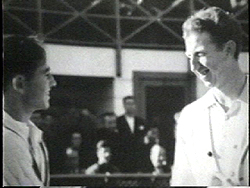 |
Bobby and his great rival Don Budge. |
Riggs greatest claim to fame, or rather infamy, was losing to Billie Jean King in the "Battle of the Sexes" in 1972, an event that helped put tennis on the media map. The massive hype around the event, fueled in large part by Riggs own relentless efforts, cast him as an aging sexist clown, a role he played to the hilt for his own profit and amusement in the years to come.
Sadly, this obscured his real place in tennis history, and his phenomenal competitive gifts. According to Jack Kramer: "Competition wise, I don't think there was anyone who was any tougher than Bobby Riggs. His ability to control the ball was the one thing I marveled at, how he could just find the spot just out of your reach."
Pancho Segura described Riggs this way: "Riggs was probably the greatest player pound per pound I ever saw. He had super coordination, no weaknesses. He had all the shots. Plus he had nerves of steel. He had concentration, motivation, and super intensity. If he thought he could beat you, you were in trouble."
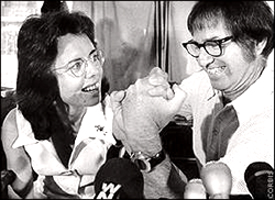 |
Frenzy and hype that overshadowed his real achievements. |
"If Bobby knew he could beat you, he might let you win a set provided you would give him a bet. He'd tease you. He'd con you. Then when you think you had him, maybe he even upped your bet. That's when he'd put you away."
"That takes control. Bobby could control his nerves that way. He did it all his life, hustling at the Los Angeles Tennis Club and everywhere else in the world. I never saw anybody else who could do that."
That was Bobby Riggs in a nutshell, a brash confident player, a gambler, a self-promoter, and a winner.



